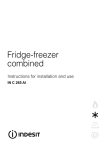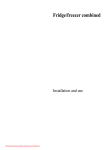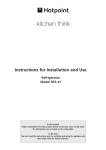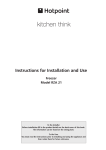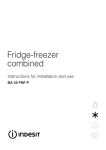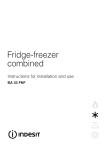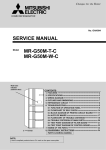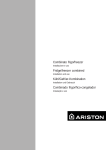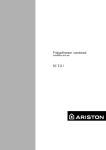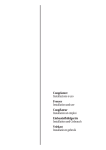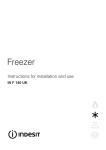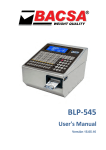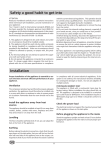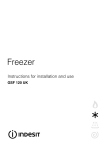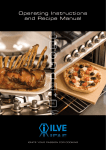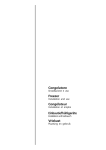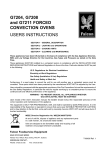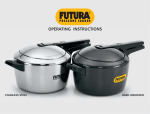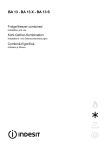Download Smeg FR298A Instructions for Installation and Use
Transcript
Frigorifero Installazione e uso Refrigerator Installation and use Réfrigérateur Installation et emploi Kühlschrank Installation und Gebrauch Frigorífico Instalación y uso Frigorífico Instalação e uso 1 Frigo-congelatore 2 porte 1 Instruzioni per l'installazione e l'uso /* Réfrigérateur-congélateur 2 portes 10 Instructions pour l'installation et l'emploi . Réfrigérateur-congélateur 2 portes 19 Instructions pour l'installation et l'emploi , Kühl-Gefrierkombination mit zwei Türen 28 Installation- und Gebrauchshinweise - Refrigerador-congeladora 2 puertas 2 Frigorífico-congelador de 2 portas Instruções para a instalação e uso 32 Instrucciones para la instalación y uso 47 Per garantire l’efficienza e la sicurezza di questo elettrodomestico: - rivolgetevi esclusivamente a centri di assistenza tecnica autorizzati - richiedete sempre l’utilizzo di parti di ricambio originali To maintain the EFFICIENCY and SAFETY of this appliance, we recommend: - call only the Service Centers authorized by the manufacturer - always use original Spare Parts Pour garantir l’efficacité et la sécurité de ce produit: - adressez-vous exclusivement aux Centres d’assistance technique agréés - demander toujours l’utilisation de pièces détachées originales Um die Leistungsfähigkeit und Sicherheit dieses Gerätes zu gewährleisten, bitte folgendes beachten: - wenden Sie sich ausschließlich an unsere autorisierten Service-Stellen - verlangen Sie, daß nur Original-Ersatzteile verwendet werden Para garantizar la eficacia y seguridad de este electrodoméstico: - Diríjase exclusivamente al Servicio Técnico Oficial del Fabricante. - Solicite siempre la utilización de recambios originales. Para garantir a eficiência e a segurança deste electrodoméstico: - dirija-se exclusivamente a centros de assistência técnica autorizados - solicite sempre a utilização de peças originais Safety - a good habit to get into. ATTENTION Read your manual carefully since it contains instructions which will ensure safe installation, use and maintenance of your appliance. Your Refrigerator is built to International safety standards (EN60) ans has been awarded the European approval mark (IMQ) for compliance with UK electrical safety requirements. It also meets the EC standards on the prevention and elimination of readio interference (EC directive 87/308 - 02.06.89). 1. This appliance must not be installed outdoors - not even in an area protected by a roof. It is extremely dangerous to leave it exposed to rain or storms. 2. It must only be used by adults and exclusively to refrigerate and freeze foodstuffs, following the instructions for use contained in this manual. 3. Do not ever touch or handle the appliance with bare feet or with wet hands or feet. 4. It is highly recommended that you do not use extension cords or multiple socket adapters. If the refrigerator is installed between cabinets, make sure that the cord is not bent or dangerously pinched or compressed. 5. Never pull on the cord or the refrigerator to remove the plug from the wall socket - this is very dangerous. 6. Never touch the cooling components within the appliance, especially with wet hands because this could result in injury. Never put ice cubes just removed from the freezer into your mouth because they could stick to your mouth and cause burns. 7. Never clean the appliance or perform maintenance without first disconnecting it from the electrical mains. Turning the thermostat knob to the setting does not suffice to break all electrical contact with the mains. 8. Before having your old refrigerator picked up for disposal, remove or make inoperable any locking devices to prevent children who might play in or around the appliance from being locked inside. 9. Before calling for service/assistance in the case of malfunction, consult the chapter entitled “Is There a Problem? to determine whether it is possible to eliminate the problem. do not try to repair the problem by trying to access the internal components of the appliance. 10. If the power supply cord must be replaced, please contact one of our Customer Service Centers. In some cases, the connections are made using special terminals and in others a special tool must be used to access the connections. 11. Do not use electric appliances inside the compartment for food storage, if these are not those recommended by the manufacturer. 12. At the end of the functional life of your appliance – containing cyclopentane gas in the insulation foam and perhaps gas R600a (isobutane) in the refrigeration circuit – the latter should made safe before being sent to the dump. For this operation, please contact your dealer or the Local Organisation in charge of waste disposal. Installation To ensure that the appliance operates properly and to reduce energy consumption, it is important that the appliance is installed correctly. Ventilation The compressor and condenser generate heat and, therefore, need to be ventilated properly. Rooms with less than perfect ventilation are not very suited for installation of the appliance. Therefore, it should be installed in a room with an opening (window or French window) that provide the appropriate amount of air re-circulation. It is also important that the room not be too humid. During installation, make sure not to cover or obstruct the grates that allow for proper ventilation of the appliance. Away from Heat Avoid positioning the appliance in a place where it is directly exposed to sunlight or near an oven, cook top or the like. Electrical Connection and Earthing Before proceeding with the electrical connection, make sure that the voltage indicated on the rating plate, located at the bottom left near the vegetable crisper, corresponds to the GB 10 mains voltage in your home and that the socket is fitted with a standard earthing wire in accordance with safety standards for 46/90 systems. If the socket is not fitted with an earthing wire, the manufacturer will not be held liability for any damages and or injuries arising out of the use of the appliance. Do not use multiple sockets or adapters. Position the appliance in such a way that you can access the socket where it is plugged in. Insufficient power? The electrical socket must be able to handle the maximum power load of the appliance, which is indicated on the rating plate located at the bottom left next to the vegetable crisper. Before making the electrical connection ... After the appliance has been delivered, place it in the vertical upright position and wait at least 3 hours before inserting the plug into the socket in order to ensure that it functions properly. A Closer Look A Thermostat knob for regulating the temperature I Light This knob is used to regulate the temperature in the two compartments with the following settings: J Compartment for storing frozen foods K Suspended ice tray L Compartment for freezing fresh foods and storing frozen foods, The refrigerator is off; 1 less cold; 5 colder B Removable shelves with lid C Adjustable shelves with railing L D Removable bottle shelves K E Fruit and vagetable bins J F Meat/cheese storage box I G Defrost water collecting conveyor H Removable shelves that cal be A B C adjusted for height H G D F E D 11 GB How to Start the Appliance NOTICE After the appliance has been delivered, stand it in the upright position and wait approximately 3 hours before connecting it to the electrical outlet to guarantee that it operates properly. Before placing foodstuffs in the refrigerator or freezer, clean the interior well with warm water and baking soda. After putting the plug in the socket, make sure that the light is on inside the appliance and then turn the thermostat knob (A) to the “3” setting. After a few hours have passed, you can place fresh food in the refrigerator compartment and frozen foods into the freezer. How to use the refrigerator compartment... The thermostat automatically regulates the temperature inside the appliance 1 = less cold 5 = colder It is recommended that a medium setting be used. To increase the amount of space, optimize arrangement and improve appearance, this appliance has a “cooling area” located within the back panel of the refrigerator compartment. When the appliance is operating, this panel may be covered with frost or droplets of water depending on whether the compressor is operating or not at a given time. Do not be concerned about this! The refrigerator is operating normally. If the thermostat knob is positioned on higher settings while the refrigerator is heavily filled and the ambient temperature high, the appliance may run continuously, resulting in the formation of frost on the back cooling area. This will lead to an increase in energy consumption. To avoid this situation, just turn the thermostat knob to a lower setting so that the appliance defrosts automatically. Storing Food in the Refrigerator Compartment Food Storage Time Location in the Refrigerator Wrapped meat and cleaned fish (use plastic wrap or pack in plastic bags) 2 or 3 days On the shelf above the vegetable crisper (which is the coldest area). Fresh cheese 3 or 4 days On the shelf above the vegetable crisper (which is the coldest area). Eggs 1 month In special egg rack on door. Butter, margarine On any shelf. Cooked or precooked food (placer in air-tight containers and when cool store in refrigerator) 3 or 4 days On any shelf. Sausages, salami, sandwich meats in general, fresh pasta, custards,puddings, chocolates, cream pastries, bread, dry pastries, red tomatoes 3 or 4 days On any shelf. Bottled products, milk, drinks, yoghurt On special door shelves. Fruits and legumes In vegetable crisper. What Not to Store in the Refrigerator Garlic (transmits odour), onions and leeks. Bananas (they will turn black). Citrus fruits. Potatoes and root vegetables (store in dark, dry places). GB 12 - Within the refrigerator compartment, the air circulates naturally, with the colder air falling because it is heavier. This is the reason why meat and cheeses should be placed above the vegetable crisper. - Please follow our instructions carefully on maximum storage time: any food, even the freshest, will not remain edible for any extended amount of time. - Contrary to popular belief, cooked foods do not store any longer than raw food. - Do not place liquids in containers without covering them because this will lead to an increase in the level of moisture within the refrigerator, causing the formation of frost. - Be careful not to place containers (plastic or glass), food or other objects in direct contact with the cooling area of the back wall of the refrigerator. This could harm the food, increase energy consumption and facilitate the formation of condensate (on food, containers, etc.). - The refrigerator compartment is equipped with convenient, removable shelves (Fig. 1) which can be adjusted for height using the shelf guides. This allows you to place even large containers and foodstuffs in the refrigerator. - The new system of “suspended trays” (Fig. 2) is moch more hygienic, plus convenient and practical as it offers better use of the freezer space; if you need nore quickly, place the trays on the bottom of the freezer. Fig. 1 Fig. 2 To preserve meat, place the cover as indicated in Fig. A. To preserve cheese, overturn the cover and place it as indicated in Fig. B. This box is not supplied with some models. A B Freezing Foods Properly - For the preparation of food to be frozen, please consult a specialized manual. - Food that has be thawed, even partially, must not be refrozen: you must cook it in order to consume it (within 24 hours) or to freeze it once again. - When freezing fresh foods, remember that they should not touch other previously frozen or deep frozen foods. Place the food that you wish to freeze in the top compartment where the temperature will fall below -18°C, which is ideal for freezing food properly. Please keep in mind that proper conservation of frozen foods depends on the speed with which they are frozen. - During the freezing process, avoid opening the door of the freezer. - The maximum daily quantity of food that can be frozen is indicated on the rating plate located to the left of the vegetable crisper. - In order to freeze and then thaw foods optimally, it is recommended that you divide food into small portions so that they freeze quickly and uniformly. The packages should be clearly marked with the content and the date they were frozen. - Do not open the freezer door in the event of a power failure or malfunction. This precaution will slow the rise in temperature within the compartment. If the door is not opened, frozen and fast-frozen foods will remain in their current state for approximately 9-14 hours. - Do not place full bottles in the freezer: they could easily burst because all liquids increase in volume when they freeze. - Fill the ice cube trays about 3/4 full. - If the ambient temperature remains below 14°C for an extended period of time, the temperature needed for extended storage of food in the freezer will not be reached, resulting in reduced storage life of the food. 13 GB Tips on Saving Energy - Install the Appliance Properly In other words, away from sources of heat and direct sunlight, in a well ventilated room complying with the minimum distances indicated in the paragraph entitled, “ Installation/Ventilation.” THE ACTUAL ENERGY CONSUMPTION OF THE APPLIANCE DEPENDS ON THE WAY THE SAME IS USED AND ON ITS LOCATION. The consumption tests were performed in 560mm deep column units, the most common installation setting for this appliance. - Use the Right Temperature Setting A setting which is too cold increases energy consumption. - Do not Overfill To conserve food properly, the cold air must circulate freely within the refrigerator. If it is overfilled, this will prevent proper air circulation, forcing the compressor to work continuously. - Close the Doors Open your refrigerator as little as possible because each time you do so you loose much of the cold air. To raise the temperature to the proper level again, the motor must work for a long time, consuming energy. GB 14 - Keep an Eye on the Seals Keep the seals clean and make sure that they adhere well to the door. This alone will ensure that no cold air escapes. - No Hot Foods A hot pot or pan placed in the refrigerator immediately raises the temperature several degrees. Let hot cookware and food cool to ambient temperature before placing them in the refrigerator. - Defrost the Freezer Check the thickness of the frost on the walls of the freezer and immediately defrost it if the layer of frost is too thick. (see the section entitled, “Keeping your Appliance in Shape”). Guide to Using the Freezer Meat and Fish Tenderising (days) Storage (months) Tinfoil 2/3 9 / 10 Not required. Lamb Tinfoil 1/2 6 Not required. Pork Roast Tinfoil 1 6 Not required. Veal Roast Tinfoil 1 8 Not required. Veal/Pork Chops Each piece wrapped in cling wrap and then in tinfoil (4 to 6 slices) 6 Not required. Veal/Lamb Cutlets Each piece wrapped in cling wrap and then in tinfoil (4 to 6 slices) 6 Not required. Minced Meat In aluminium containers covered with cling wrap. 2 Slowly in refrigerator. Heart and Liver Plastic Baggies 3 Not required. Sausages Cling Wrap or Tinfoil 2 As necessary. Chicken and Turkey Tinfoil 1/3 9 Very slowly in refrigerator. Duck and Goose Tinfoil 1/4 6 Very slowly in refrigerator. Pheasant, Partrige and Wild Duck Tinfoil 1/3 9 Very slowly in refrigerator. Hare and Rabbit Tinfoil 3/4 6 Very slowly in refrigerator. Venison Tinfoil or Cling Wrap 5/6 9 Very slowly in refrigerator. Large Fish Tinfoil or Cling Wrap 4/6 Very slowly in refrigerator. Small Fish Plastic Baggies 2/3 Not required. Crustaceans Plastic Baggies 3/6 Not required. Shellfish Store in salted water in aluminium containers or plastic containers. 3 Very slowly in refrigerator. Boiled Fish Tinfoil or Cling Wrap 12 In hot water. Fried Fish Plastic Baggies Food Wrapping Beef Roast Freshly minced 4/6 15 Thawing Time Directly in pan. GB Fruits and Vegetables Food Preparation Apples and Pears Peel and cut into slices. Apricots, Peaches, Cherries and Plums Peel and pit. Strawberries Blackberries and Raspberries Blanching Time Wrapping Storage (months) Thawing Time 2' In Containers (cover with syrup) 12 In refrigerator very slowly. 1' / 2' In Containers (cover with syrup) 12 In refrigerator very slowly. Rinse and fry. In Containers (cover with sugar) 10 / 12 In refrigerator very slowly. Cooked Fruit Cut, cook and strain. In Containers (add 10% sugar) 12 In refrigerator very slowly. Fruit Juice Wash, cut and crush. In Containers (sugar to taste) 10 / 12 In refrigerator very slowly. Cauliflower Remove leaves, cut head into small pieces and blanch in water and a little lemon juice. Cabbage and Brussel Sprouts Wash and cut into small pieces. Peas 2' Plastic Baggies 12 1' / 2' Plastic Baggies 10 / 12 Shell and wash. 2' Plastic Baggies 12 Not required. French Beans Wash and slice if required. 2 Plastic Baggies 10 / 12 Not required. Carrots, Peppers and Turnips Peel, wash and slice if necessary. 3' / 4' Plastic Baggies 12 Not required. Mushrooms and Asparagus Wash, peel and cut up. 3' / 4' Plastic Baggies or Containers 6 At room temperature. Spinach Wash and mince. 2' Plastic Baggies 12 At room temperature. Vegetable for Soups Wash and cut up in small pieces. 3' Plastic Baggies or Containers Various Foods Preparation Blanching Time Wrapping 6/7 Storage (months) Not required. At room temperature. Not required. Thawing time Bread Plastic Baggies 4 At room temperature and in the oven. Cakes Plastic Baggies 6 About 10 minutes at room temperature, cook at 100/200°C. Cream Plastic Containers 6 At room temperature or in refrigerator. Butter In original wrapping or tinfoil 6 In refrigerator. Boiled Food or Vegetable Soup Plastic or Glass Containers Eggs Freeze without shells in small containers GB 16 3/6 At room temperature or in hot water. 10 At room temperature or in refrigerator. Keeping Your Appliance in Shape Before cleaning the refrigerator, disconnect it from the electrical mains (by removing the plug from the socket or by turning off the main electricity switch for the apartment or house). Defrosting WARNING: do not damage the refrigeration circuit. Do not use mechanical devices or other tools to speed up the defrosting process, unless they have been recommended by the manufacturer. How to Defrost the Refrigerator This appliance defrosts automatically and the water is channeled to the back toward the drain installed for this purpose (fig. 3). Here, the heat produced by the compressor will make it evaporate. The only thing you must do is to periodically check and clean the hole of the drain, which is located behind the vegetable crispers, so that the water drains properly. How to Defrost the Freezer - Every so often, remove the frost with the scraper provided with the appliance (do not use knives or metal objects). - If the frost is more than 15 mm thick, the freezer must be defrosted. Cleaning and Special Maintenance - The materials used to build your appliance are hygienic and do not transmit odors. However, to preserve this quality of your appliance, the food stored in it must be well closed and covered to prevent spills which could stain it and cause unpleasant odors. - Only water and baking soda. To clean both the interior and exterior, use a sponge with warm water and baking soda, which is, among other things, a good disinfectant. If you do not have any in the house, you can use a neutral soap. - What not to use. Never use abrasives, bleach or ammonia. Solvents and similar products are strictly prohibited. - All the removable part should be taken out and allowed to soak in hot water and dishwashing soap. Rinse and dry them well before putting them back in the refrigerator. - When the appliance is not used for a long time. If you decide not to use the appliance (during the summer), it must cleaned and the doors left open to prevent the formation of mold and unpleasant odors. - How to replace the refrigerator lamp. The lamp is located on the pack part of the thermostat knob box. When replacing the lamp, disconnect the appliance from the mains, unscrew the burned out lamp and replace it with another following the steps illustrated in figure 4. Make sure that the wattage is not greater than 15W. 17 GB Is There a Problem? The refrigerator does not function. Have you checked whether: • The main switch for the electricity to the apartment or home has been turned off; • The plug is properly inserted in the outlet; • The outlet is adequate; try inserting the plug into another outlet in the room. The refrigerator and the freezer do not cool properly. If after all the checks, the appliance still does not operate or the problem persists, call the nearest Service Centre and inform them of: the type of problem, the abbreviation of the model name (Mod.) and the relative numbers (S/N) written on the rating plate located at the bottom left next to the vegetable crisper (see examples in the figures below). Mod. RG 2330 220 - 240 V- Have you checked whether: • The doors do not close well or the seals are faulty; • The doors are left open too long; • The thermostat knob is not on the proper setting; • The refrigerator or freezer is overfilled. TI 50 Hz Cod. 150 W 75 Total 340 Net Gross Gross Util Bruto Bruto Utile Brut Brut Compr. R 134 a Test Pressure HIGH-235 Syst. P.S-I. LOW 140 Kompr. kg 0,090 Made in Italy 13918 93139180000 W Fuse S/N 704211801 A Gross Bruto Brut Max 15 w Capac Class Poder de Cong Clase Freez. kg/24 h 4,0 N Classe The food in the refrigerator becomes too cold. Have you checked whether: • The thermostat knob is on the proper setting; • The food is in contact with the back wall - which is the coldest part. The motor runs continuously. Have you checked whether • The doors are not closed well or have remained open too long; • The ambient temperature is too high; • The thermostat knob is not on the proper setting. The appliance makes too much noise. The gas refrigerant produces a slight noise even when the compressor is not running (this is not a defect). Have you checked whether: • The refrigerator is level. • The appliance was installed between cabinets or objects that vibrate and make noise. There is water on the bottom of the refrigerator. Have you checked whether: • The hole for draining the water from the frost is clogged (see fig. 3). GB 18 Never call on unauthorized technicians and always refuse spare parts which are not originals. 08/2001 - 195029433.01 - Xerox Business Services DocuTech












